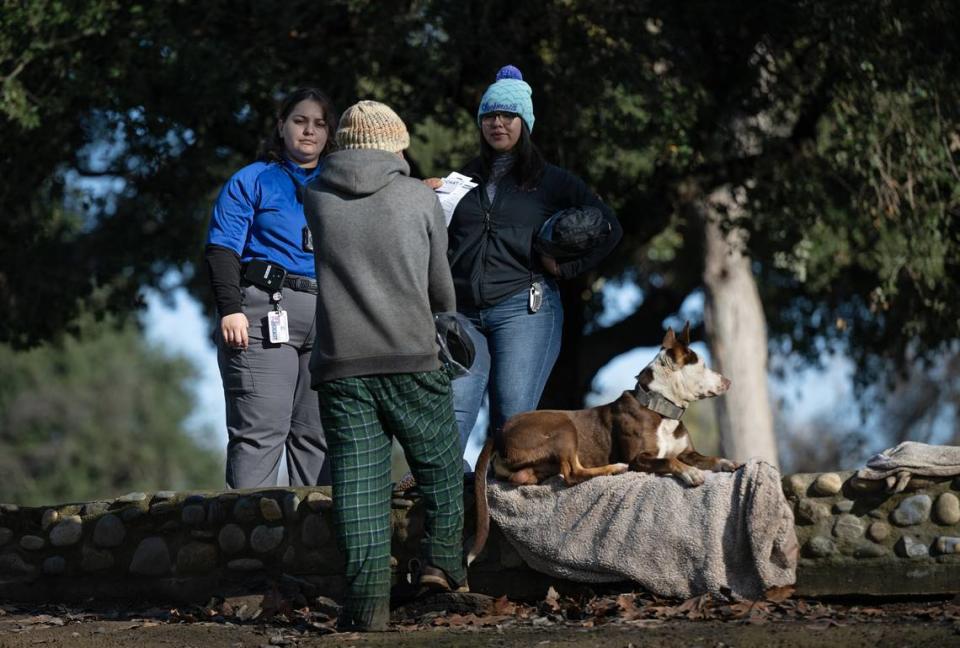How will Gavin Newsom’s order to sweep homeless encampments change Stanislaus County?
- Oops!Something went wrong.Please try again later.
Without additional resources and funding, Gov. Gavin Newsom’s order about homeless encampments might only end up moving the unhoused around to different parts of Modesto and the county.
In response to the U.S. Supreme Court’s recent decision on anti-camping laws, Newsom issued an executive order directing state agencies to begin sweeping homeless encampments from public property. This initiative is aimed at addressing encampments that pose risks to “life, health and safety.”
For Stanislaus County, where more than 2,000 people experience homelessness each night, this new policy is set to have an impact.
According to 2024 data, 79% of unhoused individuals in the county reside in Modesto. Most of these individuals live in the 95351 and 95354 ZIP codes, encompassing areas such as west Modesto, downtown, La Loma, the airport neighborhood and Yosemite Boulevard.
“Even before Governor Newsom’s executive actions, the City of Modesto has proactively invested in responding to concerns of homelessness in our community,” the city said in a statement.
Since taking office in 2019, Governor Newsom has directed approximately $24 billion towards combating homelessness.
Maj. Darren Stratton of the Salvation Army Modesto Corps said that clearing encampments won’t change how we need to support the unhoused, but it will likely put extra pressure on a system that’s already at its limit in the city and county.
He noted that among the unhoused population, there are individuals struggling with mental health and substance abuse issues, those who have lost housing due to high costs or lack of skills and an increasing number of senior citizens with nowhere else to turn.
“Working with the unhoused population is very complicated,” Stratton said.
The Berberian Shelter, with 211 beds, is consistently at full capacity. Likewise, the ACES County Shelter, operated by the Salvation Army, has 182 beds that are also fully occupied each night.
Stratton said that while the Salvation Army is dedicated to helping as many people as possible, they face limitations due to facility size, staffing and available resources.
“I do see the potential for increased requests for sheltering beds but like all agencies providing services to the unhoused, I’m not confident in the combined ability of all shelters within Stanislaus County to meet the need,” Stratton said.
He added that the center is in regular conversations with the City of Modesto and the County of Stanislaus to address the needs of the community’s most vulnerable individuals.
Councilman Nick Bavaro applauded Newsom’s actions but raised concerns about where the unhoused population will be relocated and whether the effort might be a waste of resources.
Bavaro, who represents District 4, highlighted the problem in his area -- including Downtown Modesto and La Loma -- noting that parks and sidewalks along Yosemite Blvd. are overrun with encampments.
“All you’re doing is just shuffling people from Oakdale Road and Scenic to Claus and Scenic,” Bavaro said.
He said that state funds should be redirected towards addressing mental health and addiction issues among the unhoused, though he acknowledges that many individuals on the streets are not seeking help.
Councilman Chris Ricci said that the order has minimal impact on Modesto, as the area doesn’t have many large, long-term homeless encampments.
What’s needed are more state-level adjustments to make a more significant difference in addressing homelessness, Ricci said. He suggested that the government should identify individuals who are chronically homeless and reallocate enforcement funds to support areas such as drug and mental health treatment or bridge housing projects, based on specific needs.
“The state, cities, counties, and judiciary spend millions housing the homeless in jail. Unfortunately, the result is a revolving door of arrest, incarceration, rapid release, re-arrest, re-incarceration, and re-release,” Ricci said.
Solutions
Last August, the Modesto Police Department launched the Area Command Division, which employs non-sworn personnel with expertise in mental health and resource navigation.
MPD collaborates closely with programs like the Homeless Engagement and Response Unit (HEART), the Community Health and Assistance Team (CHAT) and the Crime Reduction Team (CRT). These teams specialize in connecting individuals in mental health crises or those experiencing homelessness with appropriate resources.
Recently, MPD, along with CHAT, HEART, the Abatement Team, Code Enforcement and Park Rangers, conducted an outreach and cleanup effort in Modesto. During this initiative, seven individuals accepted shelter. These outreach and cleanup efforts are conducted regularly, offering services and shelter opportunities to those in need.
In 2023, the CHAT team received 4,917 calls, with 71% of individuals accepting services and 24% of those accepting shelter. In total, 30 individuals were provided with housing.

Bavaro believes the Governor should designate public properties as safe areas that provide access to food, water and shelter. Without such designated areas, he warned that unhoused individuals might move to private properties or other locations. Additionally, he suggested that the state should fund service providers to manage these areas effectively.
“I applaud him on having the courage to deal with the problem, but he needs to think it through on the whole picture,” Bavaro said.
Stratton argued that if the state plans to clear encampments, it must adequately fund existing shelter operations and support organizations dedicated to helping those in need. He also stressed the need to expand shelter capacity and collaborate with agencies like the Salvation Army to ensure comprehensive support services are available.
“They must find a way to address the cost of housing and the lack of inventory,” Stratton said. “There is still a lot of work to be done.”

